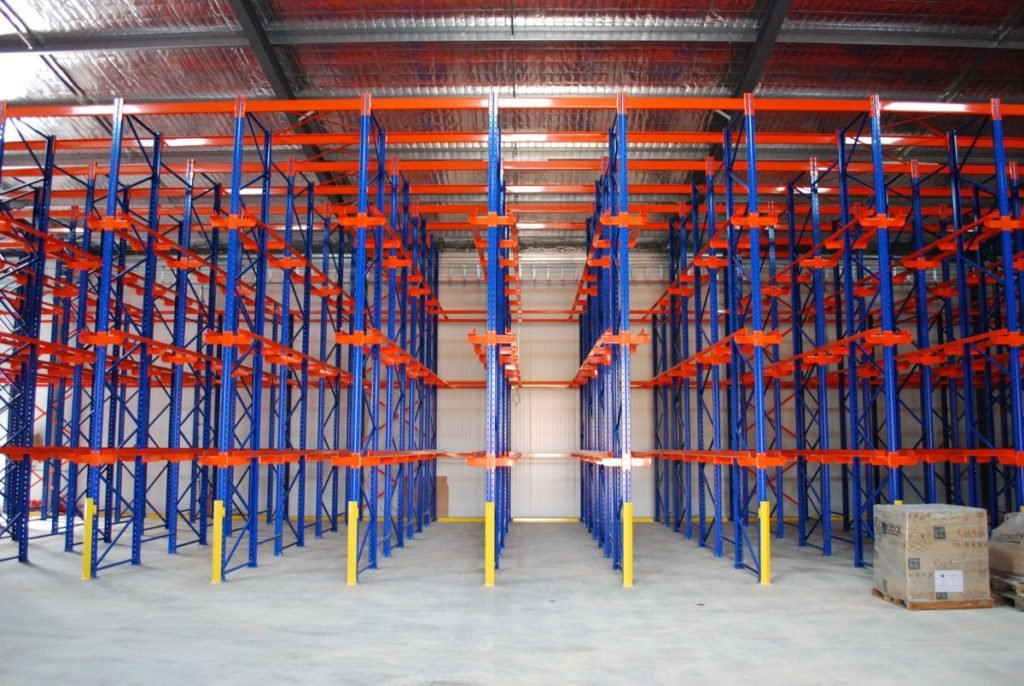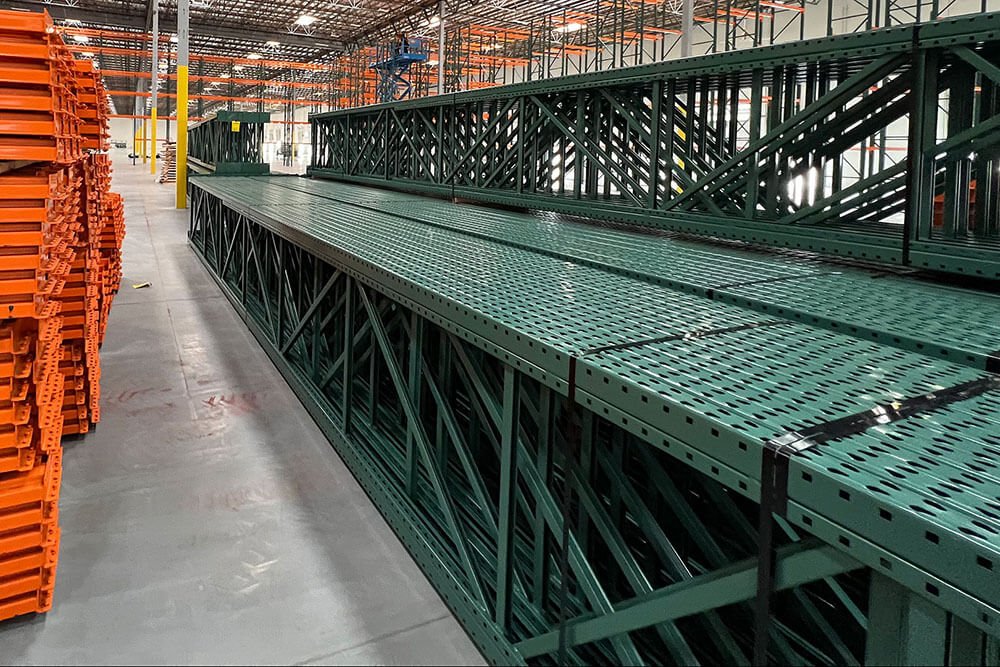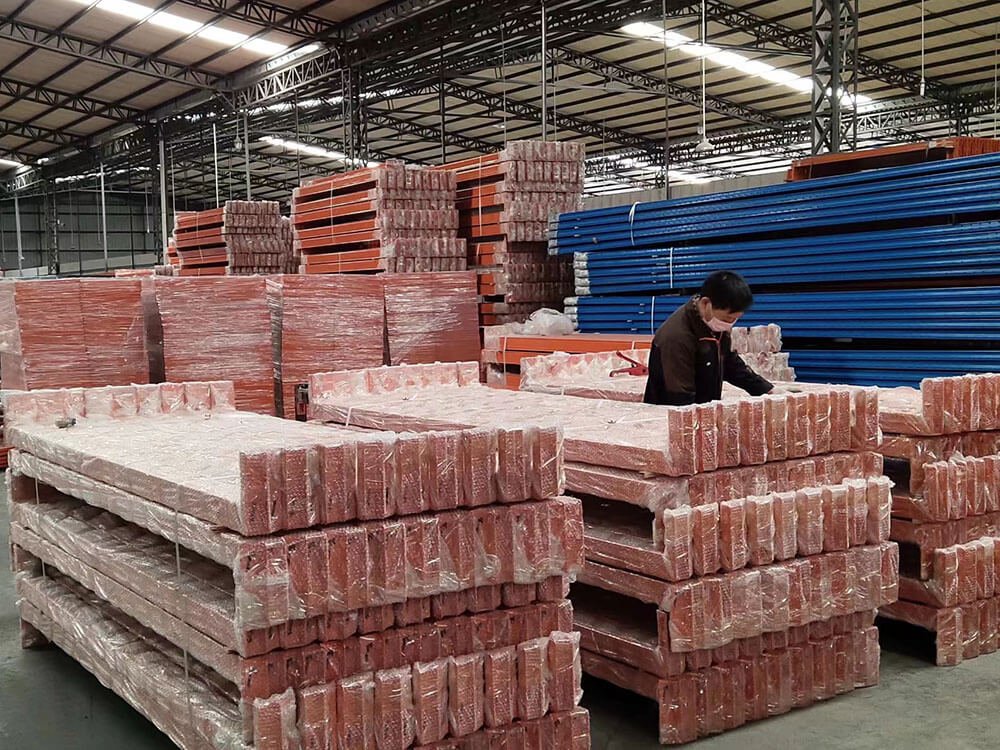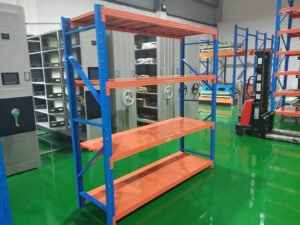Pallet racking installation is a crucial step for every business in terms of warehouse operations, workflow, and inventory accessibility. However, most warehouse managers often neglect or underestimate the importance of this process.
If warehouse pallet racks are not constructed correctly, taking into account their qualities and the site circumstances, you may not get the value you want. In certain situations, incorrect installation may be harmful to the personnel working with the racks. Thus, proper planning is critical to the installation projects’ success.
Installing pallet racks can be both easy and difficult. If you just need to install a single racking row in a compact location, you can get the work done in half an hour. Yet, if you’re in charge of a more complex project, you might need more days and even rely on the help of professionals.
This comprehensive guide will walk you through the foundation of pallet racking installation, including its importance, necessary planning before the installation, the step-by-step approach, as well as certain critical aspects in the post-installation phase.
Understanding The Necessity Of Pallet Racking Installation
Before delving into a detailed discussion about pallet racking installation, it’s essential to understand why a proper installation is critical. Let’s have a look at the various benefits it brings to warehouses:
- Enhancing racking integrity: A proper installation can protect your pallet racks’s structural integrity, thereby enhancing their durability and performance. It also helps avoid collapses that might result in damage or inventory loss.
- Maximizing storage capacity: Another great value of a proper pallet racking installation is the increased inventory capacity. Correct installation ensures the racks can support the intended load limitations, enabling maximum utilization of available storage space.
- Improving goods organization and accessibility: Well-designed and installed pallet racking systems promote better organization and accessibility of stored items. This further facilitates efficient picking, putaway, and inventory control, resulting in improved overall warehouse productivity.
- Ensuring compliance with regulations: Many jurisdictions have specific rules and building codes governing the installation and utilization of pallet racks. Proper installation guarantees strict compliance with these regulations, avoiding potential fines and legal concerns.
Planning For Pallet Racking Installation
In this section, you’ll discover some important aspects that need careful planning prior to your pallet racking installation. These preliminary steps will make your later journey smoother and faster.
Assessing Your Inventory Space
Before setting up your pallet racks, a careful examination of the available storage areas is essential. This involves measuring the warehouse floor space and ceiling height, and identifying any existing impediments, such as overhead beams or columns.
Studying the facility structure can help you choose the best racking solution and maximize inventory capacity. It’s also critical to verify that the pallet racks meet local seismic standards and floor slab requirements. Make sure to check the installation location for height issues and confirm that the floor is sturdy enough for anchoring.
Picking Your Suitable Pallet Rack Types
Which pallet racking system is ideal for your warehouse? That’s the question you must answer in this planning process. To do that, you’ll need to familiarize yourself with some rack types out there. The following is a shortlist of the top four racking systems:
Selective Racks
The most frequent rack type is the selective pallet rack, which is perfect for warehouses that store a wide range of commodities. Selective racks offer direct access to each pallet, making them ideal for operations with high turnover or those that demand immediate access to all SKUs.
When placing selective pallet racks, keep aisle width in mind to ensure that material handling vehicles can run smoothly. Check that your floor can withstand the uneven weight distribution from these racks, and be cautious of the load limitations and rack height to avoid overloading.
Drive-In And Drive-Through Racks
These two similar rack types are intended for high-density storage. While drive-in racks have only one entrance and are suitable for the LIFO approach, drive-through racks are accessible from both sides and work well with the FIFO method. They’re excellent for keeping large amounts of comparable items.

The installation of these racking systems requires top-notch stability. You’ll need to pay strict attention to the inventory lanes’ depth to prevent forklift damage and make sure that the racking structure can handle the weight of stored items, especially in tall arrangements.
Push-Back Racks
If you want to hold many pallets in a single depth, push-back racks are the go-to solution. These racking systems are appropriate for environments that demand high-density storage without losing selectivity.
All pallets are kept on a mildly inclined rail. Each time a new pallet is added, it will push back subsequent pallets, thereby providing simple access and retrieval of stored items.
It’s critical to check that the rails are correctly aligned and that the push-back function is running reliably. To minimize overloading and possible rack malfunction, you should ensure that the pallet weight is within the rack’s limit.
Pallet Flow Racks
Besides the drive-through system, pallet flow racks are also compatible with the FIFO technique. These storage solutions are true saviors when it comes to preserving perishable commodities or those with expiration dates. Pallets are typically loaded on the higher side and slid down to the opposite lower side for retrieval.
Proper roller and brake installation is crucial for the smooth operation of pallet flow racks. They should be completely level to allow a steady flow of pallets. Additionally, you must conduct regular maintenance on all elements to avoid clogs and guarantee their efficient operations.
Figuring Out Your Storage Demands
Besides selecting an appropriate pallet racking system, it’s crucial to accurately assess your storage demands when planning for pallet racking installation. Here are a few elements you should consider:
- Analyzing your stored items: Conduct a thorough process analysis of your inventory to determine the type, size, and weight of the items you’ll be storing. This information also helps you narrow down the search for suitable pallet racking systems, as different types of racks are designed to accommodate specific load capacities, item dimensions, and load distributions.
- Determining your desired accessibility: The next important consideration is your goods’ accessibility. Evaluate how frequently different commodities in your warehouse need to be accessed. For slow-moving items, drive-in or drive-through racks are suitable. But for faster-moving products that require frequent retrieval, let’s opt for selective or double-deep racks for easy access.
- Anticipating future growth: Don’t forget to consider any potential changes in product lines or storage requirements. Choosing a racking system that can accommodate future expansion will save you from the hassle and expense of frequent modifications or replacements.
- Choosing the inventory management strategy: Another decision you need to make in the planning phase is determining whether you need FIFO or LIFO storage management. People commonly use the FIFO strategy for perishable products with expiration dates, while they prefer the LIFO technique for non-perishable items or when the order of product retrieval is less critical.
Complying With Safety Procedures
The number one priority before installing a pallet rack is to ensure that it meets all applicable local standards and safety requirements, such as the OSHA (Occupational Safety and Health Administration) guideline.
Plus, all installation staff should get safety training and use proper personal protective equipment, like helmets, steel-toed boots, and safety goggles. Also, always be sure to obtain the relevant construction permissions and have the installation scheme authorized by a professional engineer.
Essential Preparations Before Pallet Racking Installation
After planning, preparations are also essential for a successful pallet racking installation. Let’s have a look at the top two most important things that need your careful preparation below:
Necessary Equipment For Installation
In addition to expertise, pallet racking installation projects need a handful of equipment. Here are some insights into the necessary apparatuses for your setup process:
- Forklifts: These vehicles are helpful in handling the racking components during installation. As different forklift models, such as counterbalance or reach trucks, are well-suited to certain racking systems or facility layouts, ensure that the forklift you want to use has the necessary load capacity and lifting height.
- Scissor lifts: It’s virtually impossible to install high-bay racking structures or those with raised levels without scissor lifts. However, before using these equipment, you need to properly train your staff on how to operate them.
- Anchoring systems: Depending on the types of racks and floor conditions, you may need anchoring systems to attach the racks to the floor. These may include expansion bolts, concrete anchors, and other specialized anchoring methods. Thus, consult a professional to figure out the best anchoring options.
- Leveling tools: In addition to shims, you may need to use additional leveling tools, like laser levels, spirit levels, or leveling jacks, to guarantee appropriate alignment of the racking system, particularly if the warehouse floor is uneven.
- Power gadgets: As previously stated, you will need power gadgets like drills, impact wrenches, and other specialized instruments advised by the manufacturers for efficient and secure installation of racking components.
- Safety barricades and signage: To facilitate a safe working environment, you should employ proper barricades and signage around the installation area to prevent illegal entry and notify others of possible risks.
- Optimal illumination and ventilation: Having sufficient lighting and ventilation is essential for safe and efficient pallet racking installation, particularly in places with little natural light or while working at high heights. It helps maintain visibility and air quality during the installation process.
- Installation manuals: Always have the required installation manuals by your side for precise directions, torque specs, and any special needs for the racking system you’re installing.
Preparation Of Installation Areas
There are numerous actions you can take to prepare the installation location. Below is a list of the most important preparatory steps you need to conduct:
- Floor testing: The first crucial step for a successful pallet racking installation is to analyze the warehouse floor condition where the racking structure will be put. Ensure that it can support the combined weight of the racking system and stored goods. If it doesn’t satisfy the load-bearing capacity requirements, strengthening measures are necessary to avoid damage and assure the racks’ stability.
- Floor preparation: If required, level the floor surface, scrape it, or add a specific coating to improve traction and longevity. This phase is important to guarantee the stability and effective anchoring of the racking system. Also, verify that the chosen spot is suitable for your intended racks, as heavy-duty systems are typically designed for installation on concrete floors.
- Marking and layout: Mark the appropriate area for racking installation using chalk lines, tapes, or other visible markers. This will aid in the correct positioning and alignment of the racking components.
- Staging area: Another quick recommendation is to create a separate staging space near the installation location to store and organize the racking elements. By doing so, you can simplify the installation procedure and reduce the likelihood of blockages or tripping hazards.
Step-By-Step Guide For Pallet Racking Installation
The process of pallet racking installation may vary depending on the kind of racking used. However, a typical process usually encompasses four main steps. After having at least two individuals for the task, you can begin the following 4-step process:
Step 1: Setting Up The Upright Frames

Serving as the backbone of your pallet racking system, upright frames are assembled first during the installation process. This stage requires precise attention to detail and rigorous adherence to the manufacturer’s guidelines.
Before starting, make sure that the upright frames are completely vertical and sturdy. Utilize levels, plumb bobs, or laser alignment instruments to obtain exact verticality. It’s also important to install each component, including bracings and footplates, properly and securely to maintain the structure’s overall stability.
Step 2: Arranging Your Pallet Racking Systems
Following the assembly of the upright frames, use the layout plan to indicate where you’ll place the racks on the floor. It’s helpful to allow enough room for aisle width requirements, the maneuvers of forklifts or pallet jacks, as well as clearances for emergency exits and fire safety precautions.
As mentioned above, it’s essential to indicate your installation spots with visible markers or chalk lines. Also, please detect and remove any possible blockages or dangers that may impede the installation process or the functioning of your pallet racking system. These include entrances, overhead lighting fixtures, pipelines, and electrical panels.
Step 3: Adding The Beams
After the first two steps, it’s time to install the horizontal beams that will support the stored pallets. You’ll need to be extremely careful here to guarantee that the rack beams lock solidly into the uprights at the correct heights. Also, it’s a must that they are level and appropriately spaced to fit the dimensions of the pallets being held.

When placing beams, select the proper gauge and size for load support. Failure to account for these issues can jeopardize the overall safety and durability of the racking structure. In certain circumstances, lifting equipment like forklifts or overhead cranes is necessary to handle and place the beams, particularly for longer and heavier ones.
Step 4: Finalizing The Installation
The last step is to carefully check the complete racking system to guarantee structural integrity and safety compliance. Before announcing the completion of this installation project, there are a few critical spots you need to examine:
- Double-checking all connections: This verification is to ensure that all the uprights, beams, and other components are securely attached and aligned per the manufacturer’s requirements. Misalignment can cause unequal load distribution and increase the likelihood of rack collapse.
- Ensuring correct weight distribution: Conduct regular audits to ascertain that the weight on your inventory solutions is spread evenly. Overloading one area may cause structural breakdowns and accidents.
- Cleaning the installation area: A final tour of the installation spot is essential for identifying and addressing any remaining risks, obstacles, or clearance concerns that were missed during the construction phase. Remove any debris or equipment that can lead to tripping hazards or safety problems.
When To Consider Hiring Professionals For Pallet Racking Installation
Honestly, regardless of your expertise and experience, it’s always a good idea to engage a professional for the installation of your pallet racking systems. Handling this process by yourself is too risky, especially when you lack the necessary skills and equipment. In the worst scenario, you may even endanger your crew’s safety.
Relying on specialists not only gives you peace of mind but also guarantees that the installation task will be completed swiftly, safely, and accurately. An expert can comprehend your warehouse layout, ensure that everything runs properly and complies with the required regulations.
It’s easy to make that hiring decision when you’re a newbie. However, things can get a bit complicated if you have expertise building racks. If the following situations apply to you, make sure to reach out to a professional, even if you know how to manage the installation yourself:
- New warehouse setup: In this case, it’s advisable to hire professional pallet racking installation services to ensure proper design, layout, and installation of the racking system from the ground up.
- Complex or high-capacity racking solutions: If your inventory facility requires complex racking configurations, such as multi-level or high-bay systems, professional installation is highly recommended. These systems demand precise engineering calculations and specialized installation techniques to ensure safety and structural integrity.
- Lacking in-house resources: If your business lacks the necessary resources, like manpower or equipment, to handle pallet racking installation properly, please defer the task to professionals. The reason is that improper installation can lead to safety hazards, goods damage, and potential legal liabilities.
- Relocation of existing racks: When relocating existing pallet racks, it’s best to rely on professional services. They can disassemble, move, and reassemble the racks safely and efficiently, making sure the proper load distribution is still there and minimizing downtime during the process.
A Quick Summary Table Of Pallet Racking Installation
Before closing out the article, let’s have a look at the topic again with the following summary table. It is intentionally created for your quick and convenient review later in the future.
| PHASE | Planning | Preparation | Installation |
|---|---|---|---|
| ACTIVITIES | Assessing storage areasChoosing pallet racking systemsUnderstanding your inventory demandsComplying with safety regulations | Getting the required equipment ready (forklifts, scissor lifts, shims, anchoring systems, etc.)Preparing the installation area | Assembling the upright framesPlacing your pallet racksInstalling the beamsConducting a post-installation examination |
Conclusion
Basically, that’s all you need to know about pallet racking installation. This is a task that you must do well, as any improper preparation or attempt to cut costs can jeopardize your staff safety and warehouse profitability.
Whether you need to engage a professional or just take the time to do everything yourself, always make sure to follow the step-by-step guide above carefully. A correct installation yields a long-lasting and reliable racking system, allowing you to maximize warehouse space and improve your workflow.
Hopefully, you have found this article helpful. If you need more intricate installations, please speak with experienced specialists. Thanks for reading!




